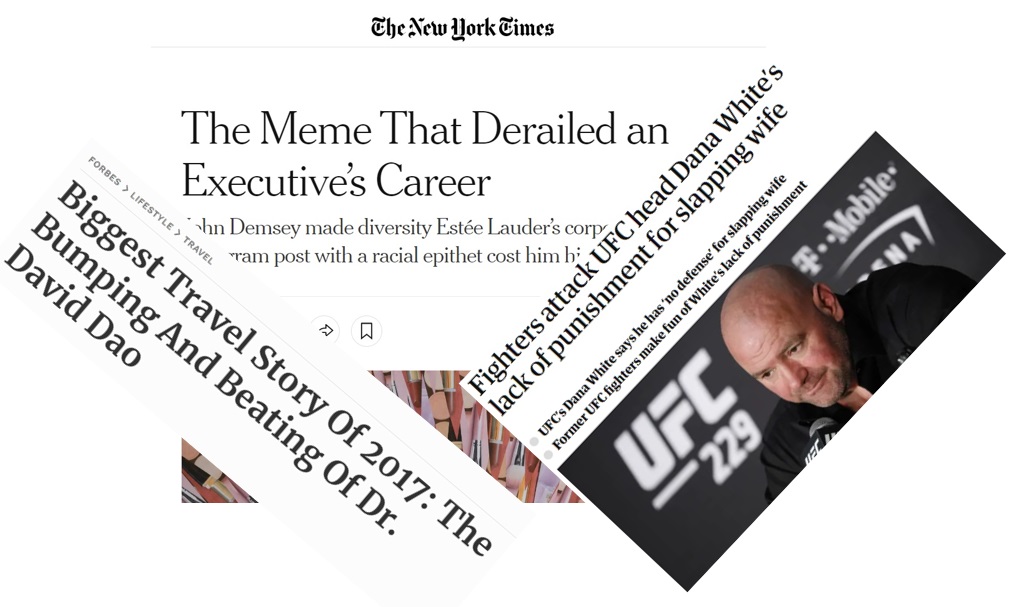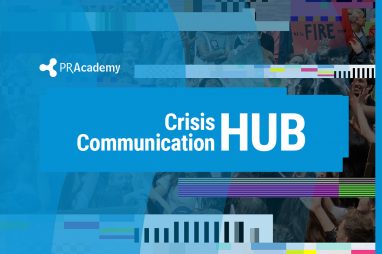Is your company prepared to navigate cancel culture?
About the author
Charlie Holding is a PR professional with five years of experience. Working closely with clients to discern their unique communication objectives, he offers a tailored advice designed to reach their specific target audiences. He also helps clients to take their public relations activities to the next level through out of the box PR ideas aimed at enhancing brand awareness and broadening audience reach. He prepared this article for a CIPR Professional PR Diploma assignment while studying with PR Academy.

Summary: Regardless of industry or sector, businesses of all sizes are vulnerable to crises. They happen daily and while some are preventable and others are not, the need to prepare for them has never been more pressing. In the age of social media where opinions can be shared instantaneously, a single unethical decision, contentious viewpoint, or tactless joke can have disastrous implications for individuals and businesses alike. Accordingly, understanding the fundamentals of crisis management and crisis communications planning is essential.

There is no way around it in today’s digital world; social media is simply part of doing business. It allows you to instantaneously share news, promote products and services, and engage with customers globally. However, criticism and public outrage travel just as quickly online. Before you know it, the same platforms you use to publicize your company can be turned against you and leave you scrambling to safeguard your reputation and mitigate lost earnings.
Your individual and organizational reputation are on the line every time you post something on social media. If the information is misleading, false, or controversial the results can be calamitous. With scores of people opting to err on the side of outrage, your company or product can be boycotted in the blink of an eye. You may even lose your job.
This trend has come to be known as cancel culture. While definitions for this polarizing term vary according to a survey by Pew Research, for the purposes of this article, I’ll define it as “the practice of withdrawing support for (canceling) public figures and companies after they have done or said something considered objectionable or offensive, usually on social media.”
Attitudes are changing
American attitudes towards and awareness of cancel culture are changing, according to the survey by the Pew Research Center, which found that 61% of US adults have heard of cancel culture, up from 44% in 2020. However, opinions on the power of cancel culture are divided.
More than half of respondents believe that calling others out on social media is more likely to hold people accountable, while 45% believe it is likely to punish those who did not deserve it. Regardless of which is correct, the target of a cancel culture attempt will face a crisis and need to communicate about it.
Proactive planning is vital
The best time to prepare for a crisis is before it happens.
Cancel culture and social media are so closely intertwined that having a robust crisis communications plan and a comprehensive social media policy are no longer optional, they are essential.
Although not all crises are avoidable, you can reduce the likelihood of one occurring by having the right tools in place. Does your company cover these basics?
Social media policy
Without a social media policy, your company is on rocky ground, making it easier to fall headfirst into a crisis. This strategic document educates your employees and clarifies what is and is not acceptable when posting on behalf of the company.
Media monitoring
If you’re not already using this service, now would be a good time to rectify this oversight. Why? Because knowing what people are saying about your brand and how they perceive you enables you to respond before a crisis escalates. With this service, all mentions of your company, positive and negative, are reported. You can also set up notifications for keywords that indicate a crisis.
Media training
Even if your company has seasoned spokespeople, there is a huge difference between promoting a product during an interview and fighting to save your brand’s reputation in a crisis. If you haven’t done so already, I strongly advise you to hire outside experts to train your public-facing team members on how to deal with the media. It’s the equivalent of taking out health insurance. You may not use it daily, but make no mistake, the time will come when you need it.
Crisis communications plan
Even if you have the basics in place to avoid a crisis, remember, one can still hit at any time, which is why you need a crisis communications plan that lays down a framework and guidelines for how to handle communication in the event of a disaster.
It helps to deliver controlled responses even in the ‘heat of the moment’ and is also an essential reference document for any staff who may be handling press relations or social media accounts. Accordingly, a dedicated social media crisis management strategy should be part of any crisis communications plan.
One of the most crucial elements is developing a crisis map to identify company and non-company-specific risks, which are then arranged by likelihood and seriousness, before determining the appropriate spokesperson and channel of communication to respond. This allows you to take swift and decisive action, which is crucial because the longer you wait to communicate with your stakeholders during a crisis, the faster the situation can snowball.
Are you talking to me?
Knowing who your stakeholders are and which channels are most appropriate to engage with them are crucial during a crisis. I’m sure you already know who your stakeholders are, but do you have a comprehensive list that groups them by importance, includes their contact information, and specifies who within your company manages your relationship with them?
If you don’t, you’re overlooking something crucial, because if you can’t reach the relationship manager during a crisis, you can’t reach that stakeholder either. Having a master stakeholder contact list solves this issue, which is why it should be part of your crisis communications plan.
Choosing the right channel
Although social media gets your message out to the widest possible audience during a crisis, discreet tactics such as internal memos, emails, or phone calls can be far more effective for personally reassuring internal audiences that the situation is under control. This reiterates the importance of having a master stakeholder contact list. For the best results, keep your messages consistent and use both internal and external communication channels to get them across.
Not every crisis is predictable
Unfortunately, no matter how hard you try, you cannot predict every possible crisis. A good example is the United Airlines scandal of 2017, which saw the company’s shares drop in value by USD1.4 billion in a matter of days. It remains one of the best case studies for public-facing executives to familiarize themselves with.
Flight 3411 was overbooked so the airline selected random passengers to be removed to make space for employees. When Dr. David Dao was asked to surrender his seat, he refused, and security violently removed him from the plane. His fellow passengers filmed the incident and posted it online. It soon went viral on social media and was viewed 6.8 million times in less than a day, sparking a huge backlash.
United’s CEO Oscar Munoz famously responded by trying to downplay the incident rather than taking responsibility and corrective action. After two tone-deaf statements from the CEO justifying the staff’s behavior and blaming Dr. Dao, thousands of people expressed their dissatisfaction on social media with the hashtag #BoycottUnitited. United Airlines shares soon took the billion-dollar hit, which some may argue is cancel culture in action.
Lessons learned
Companies must hold themselves accountable, remain transparent, and take corrective action to have any chance of saving their reputation and regaining the public’s trust. Issuing a more carefully-worded initial statement, mindful of the aforementioned points, could have stopped the United situation from escalating as it did.
Personal and professional grey areas
Although having a social media policy for those managing or using an official company account can help to prevent some online crises, companies cannot stop employees from posting their opinions on their personal social channels. This is why crisis communications plans and, more specifically, social media crisis management strategies, must factor in this variable.
Leading by example
According to research by Weber Shandwick a CEO’s reputation has a direct impact on their company’s reputation. Moreover, global executives estimate that nearly half of a company’s market value is attributable to its CEO. This puts more pressure on business leaders to act respectably both online and in real life.
In 2022, Estée Lauder, one of the world’s largest cosmetic companies, fired senior executive John Demsey after he posted a racially offensive meme on his personal Instagram account that quickly drew widespread criticism. Despite the post not coming from a company account, his association with Estée Lauder was widely known, making the company accountable by association.
The company responded swiftly, decisively, and clearly, saying: “Today, John Demsey, Executive Group President, The Estée Lauder Companies, was informed he must leave the company, effective this week. This decision is the result of his recent Instagram posts, which do not reflect the values of The Estée Lauder Companies, have caused widespread offense, are damaging to our efforts to drive inclusivity both inside and outside our walls, and do not reflect the judgment we expect of our leaders.”
Lessons learned
This statement not only distances the company from Demsey and the scandal, it shows accountability, transparency, and corrective action being taken. Crisis communications and crisis management are about damage control, and this carefully worded message is a fine example of how the company mitigated the damage Demsey’s post caused to its reputation. This is a good example of a company recognizing the power of cancel culture and taking preemptive action.
This example also highlights the importance of ensuring personal social media profiles are set to private. Even then, content meant for friends and close family can easily be forwarded. Before you post or repost anything that contradicts your company’s core values, would not be permitted on official channels, or could potentially be misinterpreted, take a moment to think carefully about the ramifications.
Cancel culture in 2023
Cancel culture is unlikely to disappear any time soon and remains just as pertinent in 2023. UFC President Dana White made headlines in January, for slapping his wife on New Year’s Eve. A video of the incident went viral on social media, leading to calls for Mr. White to relinquish his role. In the wake of the incident, UFC’s parent company, Endeavour, saw its share price drop by around 5%.
Despite the pressure of cancel culture, Mr. White said he would not be stepping down, arguing the self-inflicted damage to his reputation was punishment enough. Whether Endeavour will take further action remains to be seen. However, the impact the crisis had on the company’s financial position clearly demonstrates the correlation Weber Shandwick’s research suggests.
Social media is a fantastic tool for building brand recognition, engaging with stakeholders, and delivering better customer service. However, business leaders must remember it is a double-edged sword that has the potential to cause significant reputational and financial damage.
To reap the benefits and mitigate the risks, careful planning is required. Whether it is establishing/refining your company’s social media policy, training senior management on best practice, creating/updating your crisis communications plan, or simply learning from others’ past mistakes, acting today could help you avert a crisis tomorrow.
Although some crises are outside of your control, how you respond to them is not. Remember, accountability, transparency, and taking corrective action are fundamental to weathering the cancel culture storm. Communicating these values may not solve your crisis, but will certainly help to steer your company’s reputation back in the right direction.


